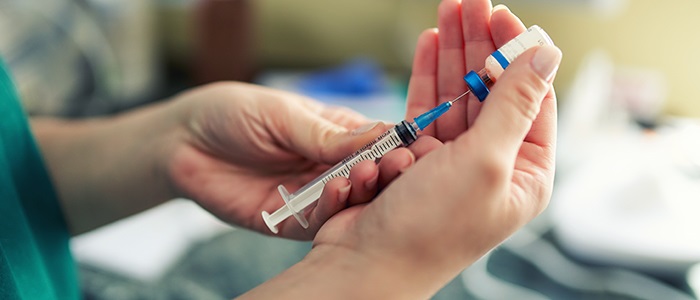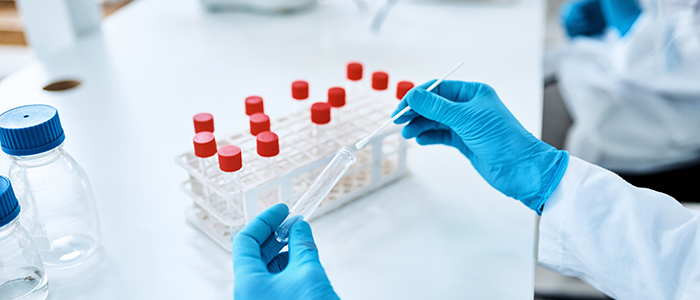While there is optimism about economic growth in 2021, reopening the economy more fully means getting the COVID-19 virus under control. What’s critical is effectively managing and administering the vaccine, underscored by President Biden’s promise for 100 million vaccinations by his first 100 days in office—a level hit 42 days early on March 19. Client Focus caught up with William Blair equity research analysts Tim Lugo and Brian Weinstein recently for an update on COVID-19 vaccines, distributions, testing, and the companies leading the efforts.
Vaccination Rate Accelerates Aided by J&J
Tim Lugo, partner, group head of William Blair biotechnology equity research

As of mid-March, the United States was dosing about 78% of distributed vaccine, up from the 50%-60% rates in the early rollout. And, now that Johnson & Johnson’s vaccine is available, the vaccination rate will accelerate. J&J is expected to distribute 20 million does by the end of March. It can be stored in a normal refrigerator and only one dose is required.
Merck partnering with J&J to manufacture its newly approved vaccine shows the kind of coordination we need to bring an end to this pandemic. Merck discontinued its internal vaccine program in February—an important step before partnering with J&J. For a company with deep vaccine experience like Merck to acknowledge it was at least a year behind the other COVID-19 vaccines and would make its greatest impact on the pandemic by partnering is the type of coordination we need to bring an end to this pandemic and return to normal.
We just saw some interesting data from AstraZeneca out of its trial in the United States, though I'm not sure what the timing will be for its U.S. filing. The next vaccine we should see new data from is Novavax’s candidate. The company just completed enrollment in its U.S.-based trial and began a rolling FDA submission for its vaccine based on trial results out of the UK. Novavax’s vaccine should be approved around May and given its relationship with the Gates Foundation and the current domestic vaccination efforts, I would expect Novavax to focus its distribution in the U.S. but include a worldwide rollout throughout the year.
There are some other very interesting next-generation candidates. One of our analysts at William Blair, Matt Phipps, follows Dynavax which produces a novel vaccine adjuvant (CpG 1018) used in several of the vaccines being developed both in the United States and abroad.
Vaccine hesitancy will quickly become the most important issue in the domestic rollout.
TIM LUGO
Update on variant boosters
Just a few weeks ago, Moderna shipped to the National Institutes of Health for clinical study a booster that will address the concerning South African variant. Additionally, both Pfizer/BioNTech and Novavax have near-term plans to enter multiple boosters targeting variants into clinical study.
So far, the variant that has spread most rapidly nationwide is UK’s (B.1.1.7). It has been found in 43 states, with larger numbers in California, Florida, and Michigan. As of March 22, these new variants are showing up in 17% of patients that are sequenced, which is up from 11% the previous week.
The emergence of variants really highlights the need to stamp down viral transmission as much as possible. And, while the work showing the efficacy of the approved vaccines against UK’s variant is early, there should be a significant amount of protection against this variant. Variants emerge when they are given a large number of hosts to transmit through.
Vaccine hesitancy rising concern
Vaccine hesitancy will quickly become the most important issue in the domestic rollout. Within months we will have manufacturing capacity to provide vaccines to any U.S. adult who wants them. And while hesitancy has declined from previous rates of about 50%, we will likely bump into that last cohort of people who are hesitant to be vaccinated this summer.
I’m a bit worried if public health messaging doesn’t continue to reach all communities that have shown concerns about vaccinations, we may not be as protected as possible heading into the fall and next winter. We have seen very few severe vaccine side effects and when you compare that to over 500,000 COVID deaths in the U.S., the negative ripples throughout the economy and healthcare system—it underscores the need to continue strong public messaging about the importance of getting vaccinated.
I’m hopeful we will reach herd immunity by summer, especially with the recent ramping up of vaccinations. It will be important to watch for the impact of the new variants over the next couple months as well as vaccine-hesitant populations as we approach the last mile of vaccinations this summer and early fall. We also won’t begin vaccinating children for some time. Hopefully by the time we have pediatric data later this year, we are well on our way to broad immunity.
COVID treatment update
Regarding therapeutics for COVID-patients, those referred to as monoclonal antibody treatments have been in the press often as the FDA has given emergency use authorization (EUA) for several of them over the past months. Monoclonal antibodies are laboratory-made proteins that mimic the immune system’s ability to fight off harmful pathogens such as viruses.
Despite the efficacy they have shown, I think the handling and administration requirements of using monoclonal antibodies has really restricted their use. I’m looking for the next generation of oral antivirals to play a more significant role in the management of the current and future pandemics. One program we are tracking is AT-527, which is being developed by Atea Pharmaceuticals and Roche Pharmaceuticals. The product likely won’t be approved and available until 2022 (pending successful clinical development). However, it can be stockpiled for years to combat future pandemics of any coronaviruses, not just SARS-COV-2, the virus that led to COVID-19.
The markets have hit some recent rocky patches but I continue to think the innovation within the biotechnology sector makes it a critical area for investment. As always, the biotechnology sector is rapidly moving so we encourage you to stay on top of the latest industry movements.
COVID Testing Shifts
Brian Weinstein, CFA, partner, group head of William Blair life sciences equity research

With the rollout of COVID-19 vaccines and fewer infections, demand for COVID testing has slowed by 30% to 50% from the peak in early 2021.
As testing of symptomatic people in healthcare settings wanes, we expect expanded testing of asymptomatic people, i.e., those who need a negative COVID test to engage in an activity such as school, camp, travel, work, entertainment, family gatherings, access to a nursing home, or pre-surgical testing. This notion is underscored by the nearly $50 billion earmarked for testing and contract tracing in the COVID relief bill, which is starting to be put to work initially in reopening schools safely.
Additionally, COVID serology testing—which can detect if a person has antibodies to COVID-19 and has played an insignificant role in the pandemic so far—could see increased value moving forward as more people demand to know if they are carrying antibodies to the virus.
Lastly, we believe COVID-19 targets will be added to almost all influenza tests to create a combo influenza/COVID-19 test, beneficial as we move into the fall flu season.
Overall, we believe COVID-19 will be endemic and, as such, there will always be some level of testing.
“Fully at-home” antigen testing
Demand for the type of tests is also changing. While molecular (PCR) testing is the gold standard in diagnostics, it is usually limited by several factors, including manufacturing scale, turnaround time for results, cost, complex instruments to run the test, and required training by lab technicians. This has largely kept molecular testing inside traditional healthcare settings.
But as society reopens and demand for COVID test with rapid results increases, we believe antigen tests and some molecular options are well suited for the shift. While antigen tests have a lower level of accuracy than PCR test, they are less expensive, require limited to no instrumentation, and have significant manufacturing capacity to address the massive amount of screening that could occur in the coming months.
This could extend to home settings.
The latest home tests to receive FDA’s emergency use authorization are referred to “fully at-home” test. The sample is collected and analyzed at home with the help software on a smartphone.
These are in contrast to home tests in which users collect samples at home and then ship them to the manufacturer or a lab for analysis.
We believe “fully at-home” tests that require no prescription will play an important role in screening for COVID-19. Again, antigen testing is best suited for these needs.
Still, there are several companies with innovative molecular diagnostic technologies that offer point-of-care tests (diagnostic tests performed at or near the place where a specimen is collected and provide results within minutes). For now, however, their scale and cost make their use more limited versus their mass-produced and cheaper antigen cousins.
We believe fully at-home tests that require no prescription will play an important role in screening for COVID-19.
BRIAN WEINSTEIN
What to watch most closely going forward
The most significant wildcard to watch going forward are the variants of the virus, which could impact the effectiveness of vaccines and cause another surge. Fortunately, the variants we have seen so far do not seem to have an effect on the diagnostics used today. But that is obviously something we need to continue to monitor for both antigen and molecular testing products.
Beyond variants, investors should pay attention to the demand in the emerging test markets—those outside the traditional healthcare environments. Keep in mind that reporting mechanisms in many of these new markets are underdeveloped or non-existent, so this demand will not fully be captured in data aggregators and public databases. So visibility to numbers will become much more limited as these testing markets replace traditional healthcare settings where test counts are more accurate.
Lastly, as we progress later into 2021, investors should monitor the impact of the flu season (which was very light in 2020-2021 given social-distancing efforts). The severity of the flu season is likely to have a profound impact on the demand for combo influenza/COVID-19 tests. At this point our expectation is for flu to come back with a vengeance this fall.
To receive the firm’s research reports, contact your William Blair representative. Visit williamblair.com/ResearchCoverage for disclosure information.



